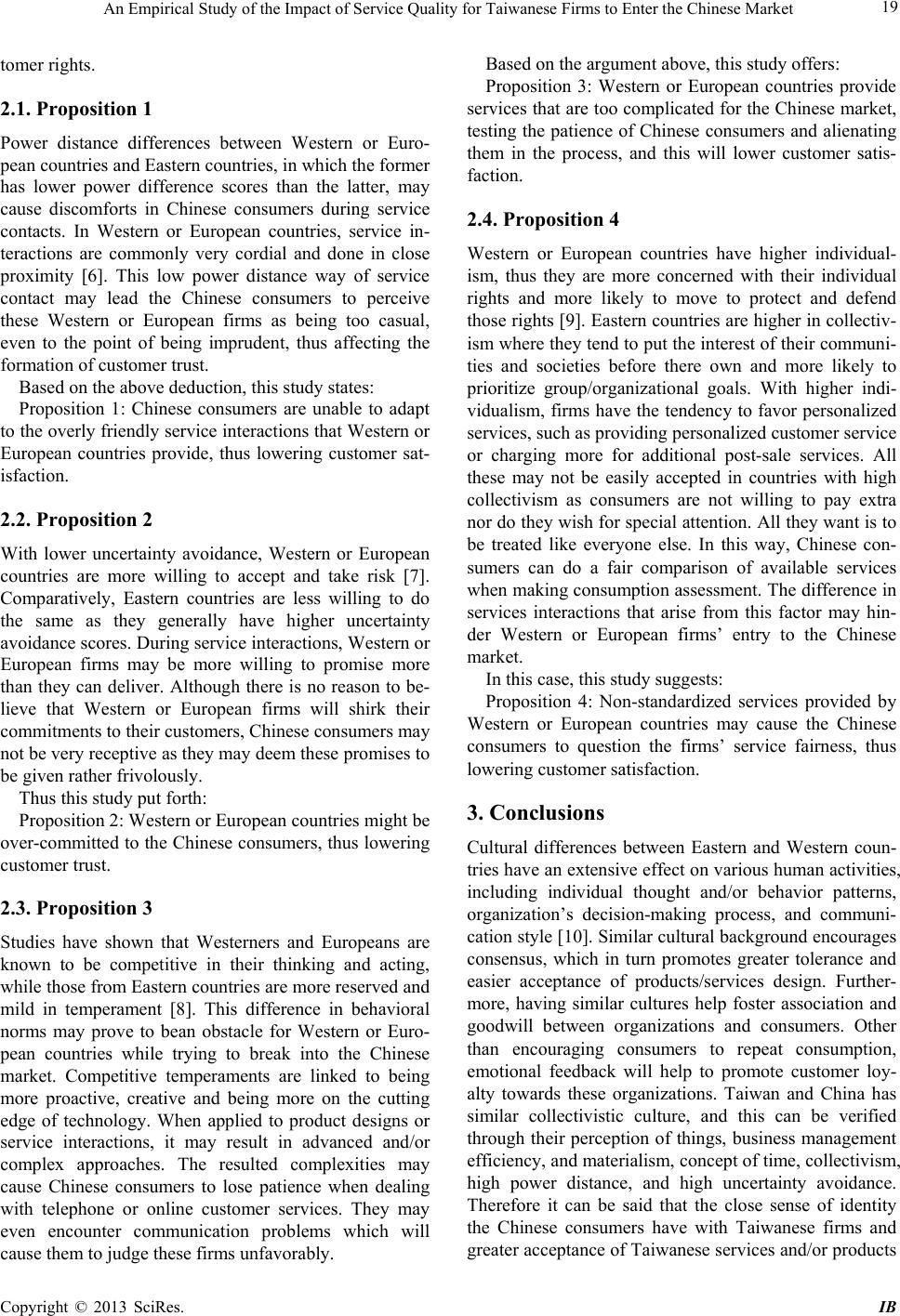
An Empirical Study of the Impact of Service Quality for Taiwanese Firms to Enter the Chinese Market 19
tomer rights.
2.1. Proposition 1
Power distance differences between Western or Euro-
pean countries and Eastern countries, in which the former
has lower power difference scores than the latter, may
cause discomforts in Chinese consumers during service
contacts. In Western or European countries, service in-
teractions are commonly very cordial and done in close
proximity [6]. This low power distance way of service
contact may lead the Chinese consumers to perceive
these Western or European firms as being too casual,
even to the point of being imprudent, thus affecting the
formation of customer trust.
Based on the above deduction, this study states:
Proposition 1: Chinese consumers are unable to adapt
to the overly friend ly service interactions that Western or
European countries provide, thus lowering customer sat-
isfaction.
2.2. Proposition 2
With lower uncertainty avoidance, Western or European
countries are more willing to accept and take risk [7].
Comparatively, Eastern countries are less willing to do
the same as they generally have higher uncertainty
avoidance scores. During service interactions, Western or
European firms may be more willing to promise more
than they can deliver. Although there is no reason to be-
lieve that Western or European firms will shirk their
commitments to their customers, Chinese consumers may
not be very receptive as they may deem these promises to
be given rathe r frivolously.
Thus this study put forth:
Proposition 2: Western or European countries might be
over-committed to the Chin ese consumers, thus lowering
customer trust.
2.3. Proposition 3
Studies have shown that Westerners and Europeans are
known to be competitive in their thinking and acting,
while those from Eastern countries are more reserved and
mild in temperament [8]. This difference in behavioral
norms may prove to bean obstacle for Western or Euro-
pean countries while trying to break into the Chinese
market. Competitive temperaments are linked to being
more proactive, creative and being more on the cutting
edge of technology. When applied to product designs or
service interactions, it may result in advanced and/or
complex approaches. The resulted complexities may
cause Chinese consumers to lose patience when dealing
with telephone or online customer services. They may
even encounter communication problems which will
cause them to judge these firms unfavorably.
Based on the argument above, this study offers:
Proposition 3: Western or European countries provide
services that are too complicated for the Chinese market,
testing the patience of Chinese consumers and alienating
them in the process, and this will lower customer satis-
faction.
2.4. Proposition 4
Western or European countries have higher individual-
ism, thus they are more concerned with their individual
rights and more likely to move to protect and defend
those rights [9]. Eastern countries are higher in collectiv-
ism where they tend to put th e interest of their communi-
ties and societies before there own and more likely to
prioritize group/organizational goals. With higher indi-
vidualism, firms have the tendency to favor personalized
services, such as providing personalized customer service
or charging more for additional post-sale services. All
these may not be easily accepted in countries with high
collectivism as consumers are not willing to pay extra
nor do they wish for special attention. All they want is to
be treated like everyone else. In this way, Chinese con-
sumers can do a fair comparison of available services
when making consumption assessment. The difference in
services interactions that arise from this factor may hin-
der Western or European firms’ entry to the Chinese
market.
In this case, this study suggests:
Proposition 4: Non-standardized services provided by
Western or European countries may cause the Chinese
consumers to question the firms’ service fairness, thus
lowering customer satisfaction.
3. Conclusions
Cultural differences between Eastern and Western coun-
tries have an exten sive effect on various human activities,
including individual thought and/or behavior patterns,
organization’s decision-making process, and communi-
cation style [10]. Similar cultur al background en courages
consensus, which in turn promotes greater tolerance and
easier acceptance of products/services design. Further-
more, having similar cultures help foster association and
goodwill between organizations and consumers. Other
than encouraging consumers to repeat consumption,
emotional feedback will help to promote customer loy-
alty towards these organizations. Taiwan and China has
similar collectivistic culture, and this can be verified
through their perception of things, business management
efficiency, and materialism, concep t of time, collectivism,
high power distance, and high uncertainty avoidance.
Therefore it can be said that the close sense of identity
the Chinese consumers have with Taiwanese firms and
greater acceptance of Taiwanese services and/or products
Copyright © 2013 SciRes. IB